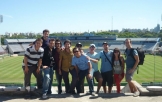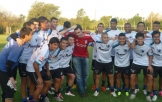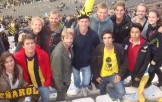Uruguay es fútbol
Selección Nacional de Uruguay
Campeones de América y del Mundo!
 En Uruguay el fútbol es un fenómeno social y cultural que supera los límites del deporte. Es una fiesta colectiva, única en el planeta y reconocida por el mundo entero. En la sangre de cada uno de los habitantes de ese país se encuentra el fútbol y es un elemento único en la identidad colectiva de sus ciudadanos.
En Uruguay el fútbol es un fenómeno social y cultural que supera los límites del deporte. Es una fiesta colectiva, única en el planeta y reconocida por el mundo entero. En la sangre de cada uno de los habitantes de ese país se encuentra el fútbol y es un elemento único en la identidad colectiva de sus ciudadanos.
Sólo de esta forma se puede intentar explicar que un país que no supera los 3,5 millones de habitantes haya alcanzado la gloria tantas veces, ya sea a nivel de clubes o de selección a nivel Continental y Mundial.
Uruguay fue campeón en los Juegos Olímpicos de 1924 y 1928, en las ciudades de Colombes y Ámsterdam respectivamente. La Selección Uruguaya deslumbró desde comienzo del Siglo XX con sus magníficas actuaciones olímpicas y se ganó desde aquel entonces la admiración y el respeto por todo el universo deportivo, colocando al fútbol sudamericano en lo más alto en épocas donde Sudamérica era ignorada en lo deportivo.
En 1930 obtuvo el primer campeonato mundial de fútbol que se disputó precisamente en dichas tierras, enfrentando a Argentina en la final, y en 1950 sorprendió al mundo derrotando en la final a Brasil en el mismísimo Maracaná, siendo este suceso histórico denominado y reconocido por todos los amantes del deporte en el planeta como “El Maracanazo”.
Luego de varios años de crisis deportiva, Uruguay volvió a sorprender al mundo ubicándose en la cuarta posición del Mundial de Sudáfrica 2010. Aunque también en la década del 70 había tenido un buen posicionamiento en el Mundial que se jugó en México.
Además, el país más chico que integra la histórica Copa América de Selecciones, es a su vez; el país que más veces la ha conquistado. 15 veces. Siendo el país que más copas Internacionales posee en Sudamérica por encima de grandes potencias como lo son Argentina y Brasil.
Uruguay también es un país claramente exportador de futbolistas, no sólo en el sentido cuantitativo, sino también por la calidad de sus futbolistas que adornan todas las ligas del Mundo, incluso el mejor jugador del último mundial en Sudáfrica fue Diego Forlán. También en Uruguay se da una particularidad, ya que es una de las naciones que más equipos de fútbol posee en todo su territorio, de Oeste a Este y de Norte a Sur. 
Club Atlético Peñarol
 El Club Atlético Peñarol nació el 28 de Setiembre de 1891, gracias al impulso de varios obreros de una empresa ferroviaria de origen británico que se encontraba en Uruguay desde 1878.
El Club Atlético Peñarol nació el 28 de Setiembre de 1891, gracias al impulso de varios obreros de una empresa ferroviaria de origen británico que se encontraba en Uruguay desde 1878.
Desde su génesis, el Club fue reconocido como el Centra Uruguay Railway Cricket Club o Peñarol, gracias al nombre del barrio que rodea la ciudad de Montevideo. A Peñarol también se lo conoce como "El Carbonero", en alusión a la zona de su creación, ya que era un barrio altamente ferroviario o también como "Manyas", gracias al apodo que le pondría un legendario jugador de su eterno Rival (El Club Nacional de Football) años más tarde.
En Marzo de 1914 el CURCC cambió oficialmente su nombre por el Club Atlético Peñarol. Este equipo posee diversos récords únicos en el fútbol Mundial, por ejemplo, a nivel nacional, Peñarol consigió el mayor invicto del Campeonato Uruguayo, con un total de 56 partidos sin perder. Récord único en Sudamerica.
Fue el primer equipo en lograr la Copa Libertadores de América de manera invicta en 1960. Además es el equipo con más participaciones en el certamen y lleva disputadas un total de 10 finales. Además es el equipo uruguayo que más Copas Libertadores ha obtenido.
En Setiembre del 2009 fue nombrado el Mejor Club del Siglo XX de Sudamérica por la Federación Internacional de Historia y Estadística de Fútbol (IFFHS).
Después de varios años de silencio, Peñarol volvió a ser finalista de la Copa Libertadores en el 2011, cuando cayó ante el poderoso Santos de Brasil. 
Club Nacional de Football
 En 1899 un grupo de jóvenes criollos deciden romper la hegemonía inglesa del fútbol en estas tierras y deciden crear un equipo de fútbol de los nacionales, es por eso que lo llaman Club Nacional de Football.
En 1899 un grupo de jóvenes criollos deciden romper la hegemonía inglesa del fútbol en estas tierras y deciden crear un equipo de fútbol de los nacionales, es por eso que lo llaman Club Nacional de Football.
Nacional es también denominado "Bolso", por una de sus primeras casacas que tenía un gran bolsillo, o "Tricolor", por los colores de su bandera, que son los mismso colores que la bandera de José Gervasio Artigas, prócer de la República Oriental del Uruguay
Nacional es uno de los equipos con más títulos en el mundo, ya sea a nivel local como internacional, y siempre ha abastecido de jugadores a la Selección Nacional de manera ininterrumpida.
El Club Nacional de Football posee su estadio denominado Gran Parque Central, estadio donde se disputó el primer partido de la primer Copa del Mundo en 1930. Es el mismo sitio donde en 1811 Artigas fue nombrado Jefe de los Orientales, hecho histórico de la emancipación de los uruguayos. 





























